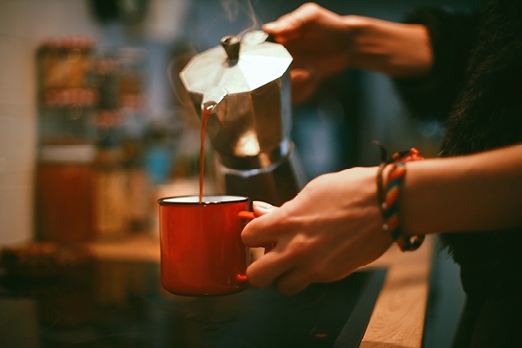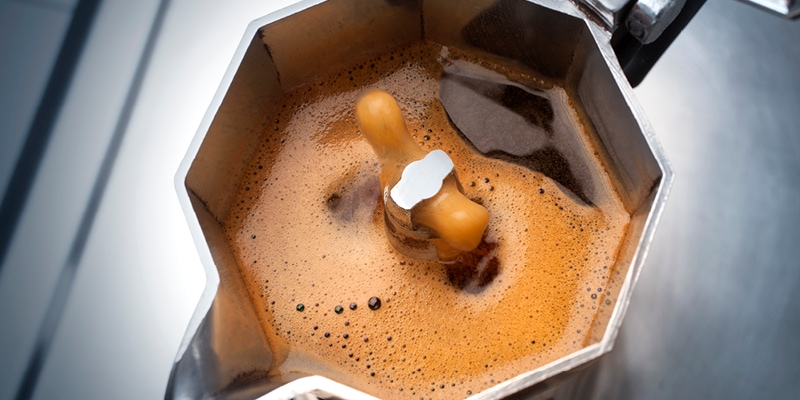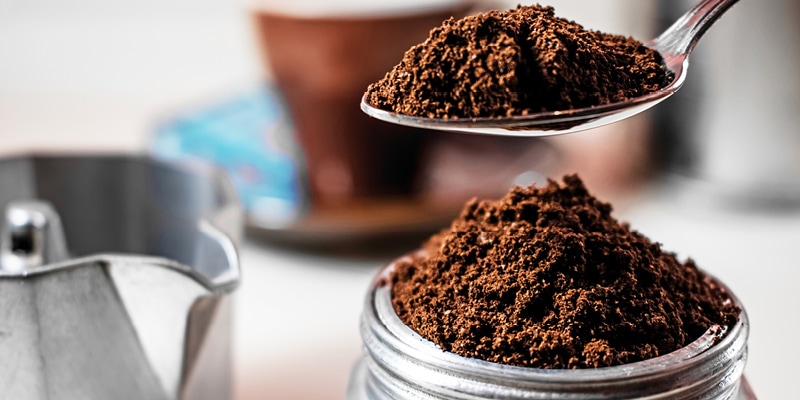The ABCs of perfect moka
Morning rituals revolve around various beverages, but we can safely say that for approximately 90% of Italian families, the moka pot steals the show. Let’s learn everything about it!

There’s a ritual that millions of Italians have: opening their eyes in the morning, climbing sleepily out of bed, going to the kitchen, and preparing themselves a cup of steaming coffee.
Morning rituals revolve around various beverages, but we can safely say that for approximately 90% of Italian families, the moka pot steals the show. For some, a good moka pot is new, lustrous, with an impeccable design which immediately gives it a sensual and graceful look. For others, the moka pot is history, tradition, and family and therefore a long-lasting object, with a slightly retro look and the markings of use and age.
Let’s learn everything about it!
ITS ANATOMY
The moka pot is made up of 3 primary components:
- the water tank (lower part) for heating the water;
- the funnel shaped filter (central part) where you put the coffee grounds;
- the coffee pot (upper part) which collects our morning dose of caffeine.
The transition of water from a liquid to gaseous state happens in the water tank. Little by little, as the state changes, the pressure increases, pushing the steam out of the only hole available: the bottom part of the filter. Thanks to the same principle, the steam continues to rise until it reaches the coffee pot, a gurgling sound announcing that the coffee is ready.

THE CHOICE
The following are some fundamental parameters that a moka pot must respect:
- the maximum temperature during the extraction phase must not exceed 90°C (unless you happen to enjoy burnt and bitter coffee);
- the maximum temperature of the coffee in the pot must be around 85°C;
- the volume of the coffee dispensed for each portion must be around 50 ml. What if a drop less comes out? You’ll survive, but perhaps with less energy!
- a minimal amount of water must remain in the tank even when the extraction has finished;
- the moka pot must be made from two materials: stainless steel or aluminum, used individually or together.
But which material is most suitable for preparing a good cup of coffee?
The first moka pot created by Bialetti was made of aluminum. This material proved to be a good choice and is still widely used to this today. Aluminum is lightweight, durable, and affordable. Furthermore, it absorbs and disperses heat easily, making it easier to control the temperature in the tank and the quality of the coffee that’s extracted.
A defect of this material is the ease with which it gets stained with use, making it appear more timeworn than it actually is. But be careful, for those who love vintage style, this might not be a defect.
If, on the other hand, you’re attracted to shine, then stainless steel is for you. This material doesn’t change over time and can be washed in the dishwasher without damaging it. Nevertheless, you have to be ready to spend more money and be aware of the fact that controlling the temperature could be more difficult. In fact, steel takes much more time to both heat up and cool down, with the risk that your coffee could have a slightly burnt taste.
EASY STEPS FOR THE PERFECT TASTING MOKA COFFEE
It might seem obvious, but the first thing is to choose the right coffee. You’ll definitely have to purchase high quality coffee in order to obtain a well-balanced taste.
In Italy, most of the coffee available in supermarkets is highly roasted, both because of cultural habits and in order to reduce the acidity present in the bean and favor the caramelization of the sugars. If you like this characteristic, go for it! If, on the other hand, you want to experiment, consider the medium roasts: they will surprise you in terms of taste and smell. These are just as suitable for preparation with a moka pot.
Once you’ve chosen your coffee, properly preparing the moka pot is fundamental. Here is a brief list of suggestions to ensure a perfect tasting moka coffee:
- cleaning your moka pot: it’s important to wash the residue of the previous preparation from all of the moka pot’s components, especially the filter;
- using mineral or filtered water: for a question of both taste and functionality. In the first case, the low presence of total dissolved solids helps to avoid interaction with the compounds present in your extract. In the second case, you avoid the formation of limescale deposits which can impair the proper functioning of the moka pot.
- quantity of coffee: the moka pot’s filter for three cups can contain from 5g to 10g of coffee, with a major difference in terms of taste. In general, the quantity of coffee grounds necessary must not exceed the border of the filter and must be completely uniform. To do this, you can gently level the coffee without however pressing it down too much, like you would for an espresso at the bar. This step is fundamental for avoiding the creation of water pathways through the coffee, something which risks extracting too much in some points and almost none in others. Nevertheless, travelling through Italy you’ll have noticed how the quantity used varies enormously depending on the region you are visiting. Keep in mind this principle: the more coffee grounds are in the filter, the longer it will take to extract the coffee and the stronger and more bitter it will be. It’s a question of taste! We recommend trying out 3-4 different doses in order to figure out which is best suited to your palate;
- avoid overly fine coffee grounds: whether you grind your coffee yourself, or it’s your favorite brand, avoid overly fine grounds. They might look nice, but they’re very (perhaps overly) bitter in the cup;
- remove coffee grounds from the border of the filter and the thread of the tank. These give a woody and burnt taste to coffee as the moka pot gets hotter;
- constant amount of heat: there’s no need to play the chemist, varying the amount of heat from start to finish of the extraction. A constant amount of heat ensures a constant extraction of coffee;
- stir the coffee: as fast as it is, there are different fractions of coffee in the extract. The lightest part will be towards the end, while the first fraction will be the most intense. Stir it so that you’ll have a homogeneous liquid.

IN CONCLUSION: THANK YOU ALFONSO BIALETTI
Many minds were involved in the creation of this tool: German, French, English, and Italian, but it was the renown Alfonso Bialetti who conceived and designed it in 1933. The birthplace of this coffee maker is Piedmont, specifically Omegna, a picturesque village on Lake Orta, once known for its metal processing.
Before the invention of the moka pot, coffee in Italian homes was prepared using the “napoletana”, also known as the “cuccumella”. The water was placed in a specific receptacle with a hole in order to avoid the generation of pressure. The grounds were placed in a filter which was then fitted into a dedicated slot. When the water would start to boil, the coffee pot was turned upside so that, thanks to gravity, the extraction process could take place in the span of 5 to 10 minutes, depending on the size of the grounds. The moka pot simplifies the process and improves the result: the reasons behind its enormous success worldwide.
Therefore: Ready, steady, moka pot in position! Here comes the coffee!

Ready to join the Vinhood family?
Vinhood is the First Italian Taste Agency. We explore the world of taste to guide people about how to choose and consume products and supporting companies in nurturing personalized relationships with their customers.
Read more
- 5 coffee-based winter cocktails
 Christmas is around the corner, and even though it won’t be like other years, we’ll be staying true to our traditions and making sure to create a festive atmosphere. No matter who you’ll be spending the holiday with, alone or in company, in this article we’ve decided to suggest several coffee-based cocktails that will bring some warmth and festivity to your celebrations. Simple cocktails that you can easily prepare at home and that we’ve classified according to our coffee characters.
Christmas is around the corner, and even though it won’t be like other years, we’ll be staying true to our traditions and making sure to create a festive atmosphere. No matter who you’ll be spending the holiday with, alone or in company, in this article we’ve decided to suggest several coffee-based cocktails that will bring some warmth and festivity to your celebrations. Simple cocktails that you can easily prepare at home and that we’ve classified according to our coffee characters. - The secrets to properly pressing coffee
 Few know that properly pressing coffee is a fundamental step in its overall preparation. But what’s the right way to do it?
Few know that properly pressing coffee is a fundamental step in its overall preparation. But what’s the right way to do it? - The 8 perfect coffee gifts
 Christmas is arriving and now it is the perfect time to pamper your friends and family with coffee stuff, whether they are already coffee geeks or just at the beginning of their journey.
Christmas is arriving and now it is the perfect time to pamper your friends and family with coffee stuff, whether they are already coffee geeks or just at the beginning of their journey.

